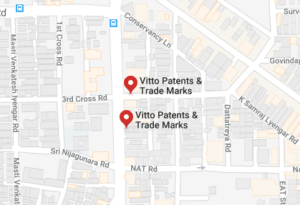TRADEMARKS
GENERAL INFORMATION
A Trade Mark is used in a business to distinguish the goods and services of one person from that of the other. It may be in the form of a Word, a logo or a symbol with unique and distinct characteristics. A brand or a mark properly promoted, is of immense value to the Company and is an Asset, which over a period of time will carry a lot of goodwill accruals. Thus, a well nourished and protected trade mark is an intangible asset to the Company. To cite a few Trademarks which have created a market niche in their respective fields are: PEPSI, TATA STEEL, NIRMA, INFOSYS, BATA, XEROX.
A Trading Style is the name of the Concern or a Company, which could also be registered, as provided by the new Trade Marks Act, 1999. Eg: GEM HOSPITAL, ARYA BHAVAN SWEETS, VIJAYA BANK.
A right in a trade mark or the trading style could be obtained by extensive user, by virtue of the Common Law Rights or by registration as provided under the Act. Dual rights exist in marks which are registered and have an extensive user over a period of time, one by the Common Law and another is the statutory right accorded by the Act, as provided under Section: 28. However, the statutory right provided by the Act is supposed to be much stronger than the common law right and as such, it is always advisable to get the trademark or the trading style registered, which shall be a strong weapon in tackling the Infringers/Potential Infringers. However, certain marks, which are laudatory in nature cannot be registered.
Eg: BEST, TOP MOST, QUALITY, HIGH CLASS.
It is advisable not to adopt marks which carry a meaning with relevance to the goods concerned, as such marks could be used by all the traders in the field and monopoly over such marks is a difficult task. A registered trademark becomes the property of the respective Concern/Firm/Company and could be assigned or licensed to a third party for a monetary consideration.
TRADEMARK REGISTRATION PROCESS
Trademark Registration is a tedious process and shall take anywhere between one and three years, depending upon the nature of the mark.
Steps involved are as follows:
Step 1 – If the mark to be registered is fairly new, it is always advisable to go in for a Trademark Search to ascertain the availability of the mark.
Step 2 – The next step is the filing of the Trademark application. A provisional or temporary number could be obtained immediately after filing and one can start using ‘TM’ but should desist using ‘R’ until Registration is granted. The date of user of the mark is an important criterion and should be indicated in the Data Form correctly, which should be substantiated with documentary evidence at a later stage and has to be amply proved, if an Opposition proceeding arises.
Step 3 – Once the application has been numbered, there is an examination report issued by the respective Trademarks Tribunal, wherein the objections raised by the Registry is listed, normally under Section: 9 & 11 of the Trade Marks Act, 1999.
Step 4 – A Hearing is held at the respective zonal offices, which will be attended by the Applicant’s Attorney and ensure the application is accepted, provided the objections are waived.
Step 5 – The application is advertised in the Trade Marks Journal, to overcome public opposition if any. A period of 4 months is available for anybody to file an opposition.
Step 6 – If the advertised application is not opposed within the prescribed time, the said application goes in for registration, finally. A registered mark needs to be renewed once in ten years, from the date of application, failing which, it shall be removed from the Register.
NOTE: Whole of the goods and services have been classified into 45 Classes. If the mark is used for goods falling under different classes, there is a necessity to file multiple applications in the appropriate classes, to cover the relevant goods and services.
INTERNATIONAL TRADEMARK REGISTRATION
Trademark Laws are territorial in nature. Owing to Global commerce/supply of goods or services in various countries, it becomes important to protect one’s brand in accordance with the IPR laws prevailing in the country of trade/sale in order to avoid infringement/passing off. Thus, securing trademark protection in various countries becomes vital.
Trademark protection under Madrid System
The system of international registration of marks is governed by two treaties:
- The Madrid Agreement concerning the International Registration of Marks
- The Protocol Relating to the Madrid Agreement
Under the Madrid Protocol, a mark can be protected in many jurisdictions by filing an application for international registration. Such application is presented to the International Bureau of the World Intellectual Property Organization at Geneva, through the office of origin i.e. the trademark office of the applicant. Where the application complies with the applicable requirements, the mark is recorded in the International Register and published in the WIPO Gazette of International Marks. The International Bureau then notifies each Contracting Party in which protection has been requested whether in the international application or subsequently. Each designated Contracting Party has the right to refuse protection of mark by so notifying to the International Bureau within the time limits specified in the Madrid Protocol. Unless such a refusal is notified to the International Bureau within the applicable time limit, the protection of the mark in each designated Contracting Party is the same as if it had been registered by the Office of that Contracting Party. An international registration remains dependent on the mark registered or applied for in the Office of origin, for a period of five years from the date of its registration. If, and to the extent that, the basic registration ceases to have effect within this five-year period, the international registration is no longer protected. An international registration subsists for the period of 10 years from the date of its registration and it may be renewed further by paying renewal fee before the expiry of every 10 years. All changes subsequent to the international registration, such as a change in name and/or address of the holder, a (total or partial) change in ownership of the holder or a limitation of the list of goods and services in respect of all or some of the designated Contracting Parties, may be recorded and have effect by means of a single procedure with the International Bureau and the payment of one fee
Steps for International Filing of Trademark through Madrid Protocol
Step 1 – A person who is a citizen of India or domiciled in India (or) Who has a real and effective Industrial or commercial establishment in India and
Who has got registration of a trademark or whose application for registration of trademark is pending in Indian office, may make application for international registration of his trademark.
Step 2 – Application must be filled only through the gateway for on line filing of International applications made available at the official website www.ipindia@nic.in
with handling fee in INR 2000/-
Step 3 – The Trade Marks Registry (TMR) verifies as to eligibility of the applicant and contents of the International Application vis-a’-vis basic registration/application.
Step 4 – When the International Application is not proper, the TMR sends a deficiency letter at the email of the applicant.
The applicant shall prepare a reply to the deficiency letter and upload it, with supporting documents, if any, through the gateway.
Step 5 – When International Application is proper the TMR certifies and transmits such applications to the International Bureau of WIPO.
Step 6 – The fee for International Application and the individual fee/Complementary fee for designated countries wherever applicable is to paid directly to the International Bureau of the WIPO, in Swiss Francs.
Step 7 – The IB of WIPO examines such applications for formalities.
Step 8 – In case any irregularity (regarding classification of goods or services) is found, the IB communicates such irregularities to the TMR as well as to the applicant. TMR also sends irregularities to the applicant by email. The applicant has to rectify irregularities and prepare a reply to the irregularity letter, and upload it, with supporting document, if any, through the gateway. TMR sends response to irregularities to the International Bureau of WIPO.
Step 9 – If International Application is found to be proper by the IB of the WIPO. It is registered with the IB, published in the WIPO gazette and transmitted to the offices of the designated Contracting Parties.
Paris Convention for the protection of Industrial Property
The Paris Convention applies to industrial property in the widest sense, including patents, trademarks, industrial designs, utility models , service marks, trade names, geographical indications and the repression of unfair competition. Paris Convention for the protection of Industrial Property, was one of the first instruments to bring harmony between patent regimes of various jurisdictions.
The substantive provision of the convention fall into three main categories:
- National Treatment
- Right of Priority
- Common Rules



